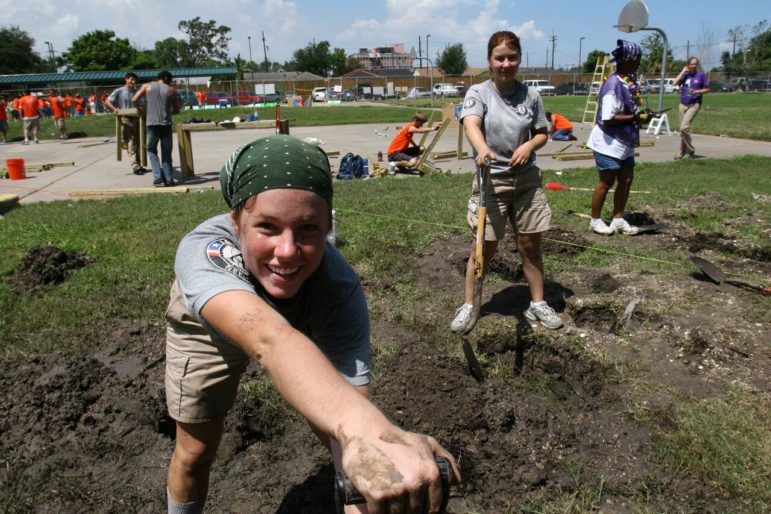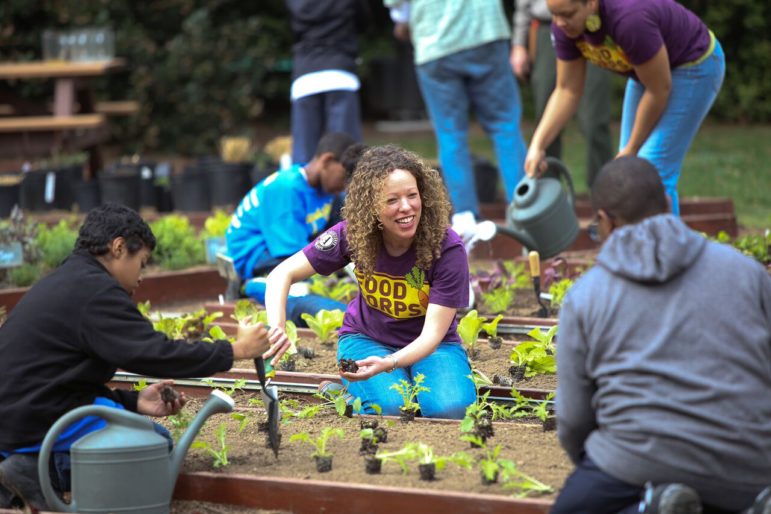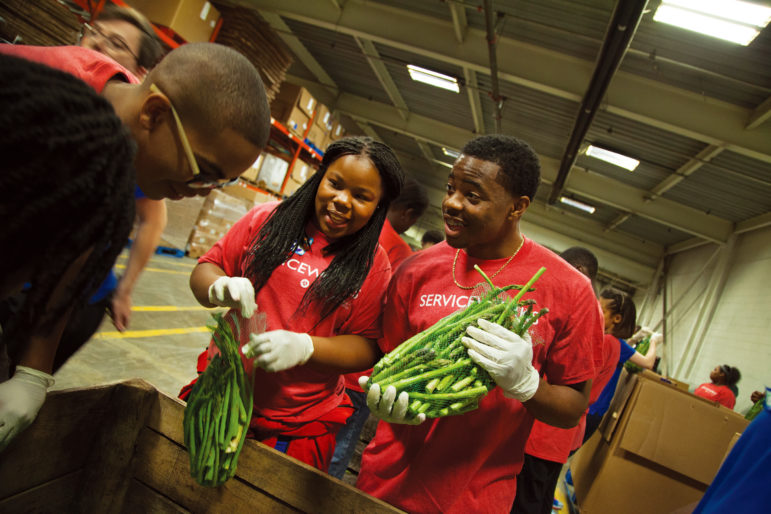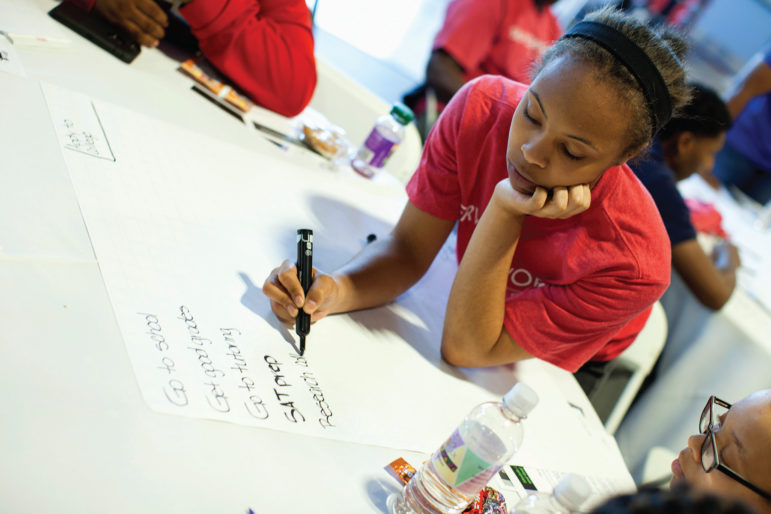
Photo courtesy of Americorps NCCC
Service Year corps members with AmeriCorps NCCC (National Civilian Community Corps) are 18- to 24-year-olds working full time in teams to revitalize neighborhoods across the country. Corps members get room and board, a living allowance, health benefits and an education award of up to $5,500.
At Green City Force, transparency starts from day one for the young adults who are considering the environmental service program after hitting a dead end on their education and career paths.
At the first information session, staff members start putting together the story of the lives of prospective members in New York City. They want to know their motivations, strengths and weaknesses — and they’re already thinking about the kinds of jobs they can introduce participants to during and after the program.
Simultaneously, they’re offering as much detail to their prospective members about Green City Force as they can: the commitment it requires and the hard work it entails.
The goal is that everyone understands fully the project they’re embarking on, increasing the chances of success — in the program and beyond — for the young adults ages 18 to 24 who live in NYC public housing.
The leaders at Green City Force want their service program to be a launching pad into a career or further education, not a temporary solution. The goal is to benefit youth who risk getting left behind economically.
“Youth unemployment is so huge. They need an opportunity. They need someone to believe in them and give them a chance,” said Dennis Acevedo, chief program officer for Green City Force.
Service programs across the country are paying attention to how they support opportunity youth, young people usually defined as those ages 16 to 24 who are not connected to school or work.
The nation’s 6 million opportunity youth face long economic odds. They’re less likely to be employed than their peers and more likely to rely on government aid. Without connections to school and work, their health can suffer and they’re more likely to enter the criminal justice system. The costs hit individuals and society in terms of lost wages, taxes and potential, say researchers.
While some programs have made this population central to their missions and offerings for decades, others are newly interested as policymakers have stressed the importance of opportunity youth at the individual and societal levels.
Creating New Paths
Service programs are different than part-time volunteer opportunities. They ask participants of all ages and backgrounds to volunteer full-time to improve their communities in a variety of ways, from building houses and tutoring to managing natural resources and providing disaster relief.

Photo courtesy of Foodcorps
Service Year corps member who serve with FoodCorps help connect kids to healthy food in school. Serving as an AmeriCorps member with FoodCorps is a fulltime, 11-month commitment, with 1,700 service hours from September to July.
Some provide job skills training, stipends, or educational awards to their members. In 2013, about 125,750 people participated in a formal national service program that required a long-term commitment, many of them youth, according to a report released by the Aspen Institute.
Service program officials say their programs are a boon to both participants and communities, and offer opportunity youth a unique way to re-engage with the workforce.
Participants develop skills such as teamwork and problem solving that are essential to 21st century success, say program leaders. They also have the chance to build a professional network, an advantage in job searching that few opportunity youth would otherwise come by. And, in some programs, they can secure money for education in return for their service, a jumpstart for young people scrambling to finance college.
Service programs also can offer a boost to young people who have long been told they, their families and their communities need help, not that they have knowledge, skills and ideas to help themselves and others.
“There’s a real power in seeing yourself as a contributor. That can be the magical piece,” said Shirley Sagawa, president and CEO of the Service Year Alliance, an organization that wants to make full-time service a common experience for all young Americans.
AnnMaura Connolly, president of Voices for National Service, an advocacy group for federally-supported service opportunities, said service programs are always pushing for additional funding to expand the number of slots available nationally, but the service concept does enjoy strong bipartisan support overall. Lawmakers are interested in how to outcomes for young adults, especially when those ideas don’t break the bank. They also look to service programs as a way to bridge economic and racial divides.
“We do need institutions that bring together people of different backgrounds,” Connolly said. “It’s a powerful idea for this time.”
Building a Supportive Program
Experts agree one key to building a supportive service program is to provide wraparound services. Participants need to learn how to write a resume and go to career counseling, not just complete their field hours and go home, said Monique Ellington, Chicago director of the Service Year Alliance.

Photo courtesy of Serviceworks
ServiceWorks aims to engage 25,000 young people in volunteerism to develop skills needed for college and careers. The organization says participating in volunteer service projects can help young people realize their ability to make a positive impact in their community.
They may also need help learning how to navigate public transportation or to use the educational funding they will receive at the end of their service, she added.
Green City Force’s Acevedo said participants also should build skills such as showing up on time every day, dealing with conflict and taking initiative.
At Green City Force, staff members create a “feedback culture,” offering constant praise and recommendations for growth, and working with participants to create a plan if they’re falling short of their obligations. They also ask participants to learn to give feedback to staff and peers, so they know how to offer constructive criticism.
Participants also attend in community meetings, where they can share how they are feeling. This is usually when Acevedo starts to see clearly the changes in young people who may have been shy or acting tough to get through the days.
“They’re transforming and starting to express themselves. They’re sharing hopes,” he said.
A social worker on site works with the participants on barriers to their service or career opportunities, such as childcare or transportation, and is simply able to listen to their problems and offer guidance.
A second key component, say Ellington and Acevedo, is to offer meaningful connections to employers.
In Chicago, Ellington is helping to build a network of employers eager to hire service alumni. She works in partnership with the 100,000 Opportunities Initiative, a coalition of companies committed to training and hiring 100,000 opportunity youth by 2018.
Though the work is still in its earliest stages, Ellington said events like career fairs can help bridge the gap between service programs and their participants, and employers. Both groups are eager to forge relationships early, before youth reach the end of their service and ask, ‘What’s next?’”
At Green City Force, Acevedo and his coworkers are in constant communication with employers about the skills they need in the field, to ensure participants are getting the training they need to succeed. Each year, about 100 members participate in the program, in a 6- or 10-month option, and 80 percent graduate.
Ellington said she’s also looking to bolster relationships with community-based organizations, such as after-school programs, to ensure potential participants consider service programs. Often the staff at those programs know young people the best and are well-suited to talk with them about barriers to participation and the potential benefits.
“You have to be in the community to gain trust,” she said.
Long-term impact
Mary Bruce, co-executive director of AmeriCorps Alums, an enterprise of Points of Light, said service can be a powerful experience, but there’s too little data about how service alums fare long-term, let alone the opportunity youth among them.

Photo courtesy of Serviceworks
Programs like ServiceWorks teach basic project management skills to disconnected youth, making it more tangible by applying what they’ve learned to goals such as applying to college or getting a job.
Organizations should collect more data about what happens to participants once they complete their service and provide ongoing support to alumni, especially opportunity youth who may face barriers to finding employment, she said.
In addition, Bruce said service programs should work closely with the nonprofit and government sectors that hire many service alumni.
Together, they should consider whether opportunity youth will be able to thrive in those environments when faced with low wages or few training opportunities that keep them engaged. If not, public sector employers miss their chance to hire and retain the diverse workforce represented by opportunity youth.
“We want to make sure everyone who raises their hand has the opportunity to continue to contribute,” she said.
Resources
These groups can help teenagers and young adults get acquainted with the idea of service and find a program right for them. Organizations also offer tips on hosting volunteers through their programs.
AmeriCorps (nationalservice.gov/programs/americorps) is the nation’s largest service program for youth, offering different stipends and educational awards associated with each of three programs:
- VISTA, a year of service at a nonprofit organization or public agency for volunteers ages 18 and older;
- The National Civilian Community Corps, a residential program through which volunteers ages 18 to 24 serve 10-month terms and complete projects throughout their region;
- AmeriCorps State and National, a network of local service programs that accept volunteers ages 17 and older for full- or part-time service during a year.
Service Year Alliance (serviceyr.org) a bipartisan organization, wants to make a year of full-time service a typical experience for Americans. The group brings together three major players in the service field — the Franklin Project, ServiceNation and the Service Year Exchange. The alliance hosts a search function that allows young people to find opportunities in their state in various areas of focus, as well as a place for potential volunteers to build a profile and share their interests.
Youth Build (Youthbuild.org), a pioneer in bringing together service and opportunity youth, has 260 programs in 46 states where young adults ages split their time between education and service. The programs are led by local nonprofits, community colleges and public agencies. Prospective members can find a local program through the website.
FOR MORE INFORMATION ON CAREER EDUCATION FOR YOUTH, GO TO THE YOUTH TODAY OST HUB.




























